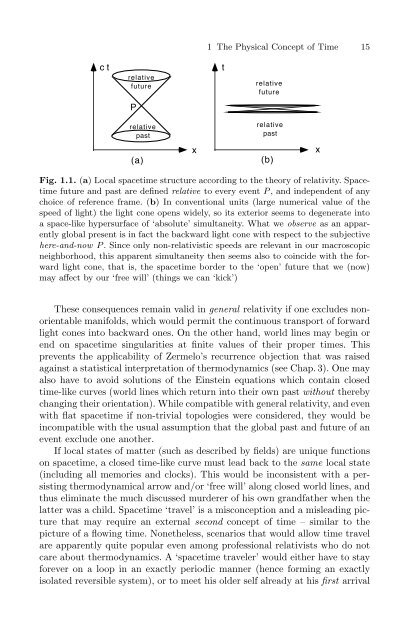The Physical Basis of The Direction of Time (The Frontiers ...
The Physical Basis of The Direction of Time (The Frontiers ...
The Physical Basis of The Direction of Time (The Frontiers ...
Create successful ePaper yourself
Turn your PDF publications into a flip-book with our unique Google optimized e-Paper software.
1 <strong>The</strong> <strong>Physical</strong> Concept <strong>of</strong> <strong>Time</strong> 15<br />
ct<br />
relative<br />
future<br />
t<br />
relative<br />
future<br />
P<br />
relative<br />
past<br />
relative<br />
past<br />
(a)<br />
x<br />
(b)<br />
x<br />
Fig. 1.1. (a) Local spacetime structure according to the theory <strong>of</strong> relativity. Spacetime<br />
future and past are defined relative to every event P , and independent <strong>of</strong> any<br />
choice <strong>of</strong> reference frame. (b) In conventional units (large numerical value <strong>of</strong> the<br />
speed <strong>of</strong> light) the light cone opens widely, so its exterior seems to degenerate into<br />
a space-like hypersurface <strong>of</strong> ‘absolute’ simultaneity. What we observe as an apparently<br />
global present is in fact the backward light cone with respect to the subjective<br />
here-and-now P . Since only non-relativistic speeds are relevant in our macroscopic<br />
neighborhood, this apparent simultaneity then seems also to coincide with the forward<br />
light cone, that is, the spacetime border to the ‘open’ future that we (now)<br />
may affect by our ‘free will’ (things we can ‘kick’)<br />
<strong>The</strong>se consequences remain valid in general relativity if one excludes nonorientable<br />
manifolds, which would permit the continuous transport <strong>of</strong> forward<br />
light cones into backward ones. On the other hand, world lines may begin or<br />
end on spacetime singularities at finite values <strong>of</strong> their proper times. This<br />
prevents the applicability <strong>of</strong> Zermelo’s recurrence objection that was raised<br />
against a statistical interpretation <strong>of</strong> thermodynamics (see Chap. 3). One may<br />
also have to avoid solutions <strong>of</strong> the Einstein equations which contain closed<br />
time-like curves (world lines which return into their own past without thereby<br />
changing their orientation). While compatible with general relativity, and even<br />
with flat spacetime if non-trivial topologies were considered, they would be<br />
incompatible with the usual assumption that the global past and future <strong>of</strong> an<br />
event exclude one another.<br />
If local states <strong>of</strong> matter (such as described by fields) are unique functions<br />
on spacetime, a closed time-like curve must lead back to the same local state<br />
(including all memories and clocks). This would be inconsistent with a persisting<br />
thermodynamical arrow and/or ‘free will’ along closed world lines, and<br />
thus eliminate the much discussed murderer <strong>of</strong> his own grandfather when the<br />
latter was a child. Spacetime ‘travel’ is a misconception and a misleading picture<br />
that may require an external second concept <strong>of</strong> time – similar to the<br />
picture <strong>of</strong> a flowing time. Nonetheless, scenarios that would allow time travel<br />
are apparently quite popular even among pr<strong>of</strong>essional relativists who do not<br />
care about thermodynamics. A ‘spacetime traveler’ would either have to stay<br />
forever on a loop in an exactly periodic manner (hence forming an exactly<br />
isolated reversible system), or to meet his older self already at his first arrival



![arXiv:1001.0993v1 [hep-ph] 6 Jan 2010](https://img.yumpu.com/51282177/1/190x245/arxiv10010993v1-hep-ph-6-jan-2010.jpg?quality=85)


![arXiv:1008.3907v2 [astro-ph.CO] 1 Nov 2011](https://img.yumpu.com/48909562/1/190x245/arxiv10083907v2-astro-phco-1-nov-2011.jpg?quality=85)








![arXiv:1002.4928v1 [gr-qc] 26 Feb 2010](https://img.yumpu.com/41209516/1/190x245/arxiv10024928v1-gr-qc-26-feb-2010.jpg?quality=85)
![arXiv:1206.2653v1 [astro-ph.CO] 12 Jun 2012](https://img.yumpu.com/39510078/1/190x245/arxiv12062653v1-astro-phco-12-jun-2012.jpg?quality=85)
